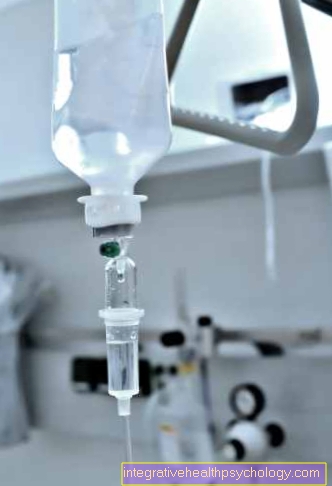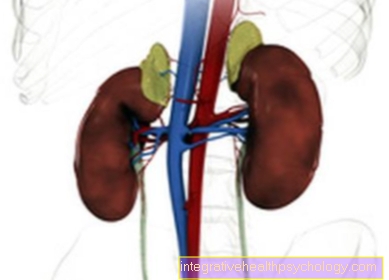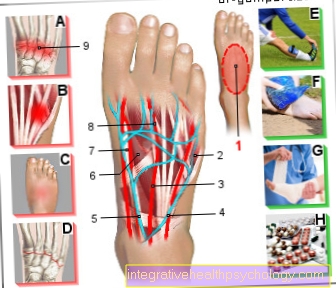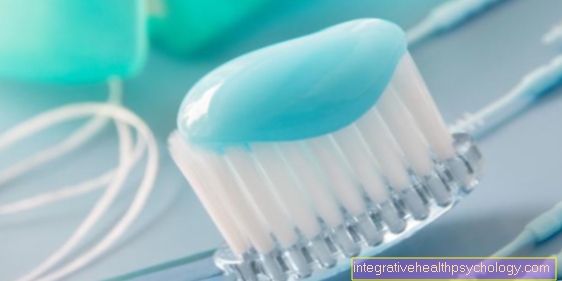The Betaisodona® ointment
Introduction - What is Betaisodona® ointment?
Betaisodona® ointment is an antiseptic (germicidal agent) that is applied to the skin. It contains iodine as an active ingredient in a chemical compound. Betaisodona® ointment is used to treat injuries or open wounds.
The ointment can be purchased at the pharmacy without a prescription and is often part of the medicine cabinet. In contrast to the alcohol-based iodine tinctures that were often used in the past, Betaisodona® ointment does not cause skin irritation associated with severe burning. However, poorly healing wounds and large injuries such as cuts or burns should always be seen by a doctor. Side effects from Betaisodona® ointment are rare and can occur in the form of intolerance reactions or an impairment of the thyroid function.

Indications for the Betaisodona® ointment
The indications for Betaisodona® ointment are, among other things, superficial wounds, such as those that can be inflicted in everyday sports or at home.
- For example, the medicine can be used for slight abrasions on the knees or elbows after a fall or scratched insect bites.
- But also a pressure sore, as can occur in bedridden people (Decubitus), is often an indication with a germicidal agent such as Betaisodona® ointment. The same applies to lower leg ulcers that can arise due to a venous disease.
- Betaisodona® ointment is also indicated in many cases for burn wounds.
- The product is also used to treat wounds that have become infected due to germs such as bacteria that have entered.
With the exception of banal everyday injuries, treatment should always be given for the other indications mentioned with the involvement of a doctor or a trained nurse.
You might also be interested in this topic: Wound healing
Can I put Betaisodona® ointment on open wounds?
Betaisodona® ointment is also suitable for smearing on open wounds. In the case of such wounds in particular, penetrating bacteria, which are naturally found on the intact surface of the skin, can lead to inflammation. The use of Betaisodona® ointment or another product with a comparable effect kills germs and thus prevents wound infection. You don't have to worry that the use of Betaisodona® ointment on an open wound will burn a lot, as the iodine contained there is only gradually released from its chemical compound.
A doctor should always be consulted in the case of large open wounds and, in particular, cuts or burns. If necessary, more extensive wound care is required and the tetanus vaccination protection should also be checked. Open wounds on the lower legs and pressure sores in bedridden people can also be treated with Betaisodona® ointment but should also be assessed by a doctor.
Read more about this: tetanus
Betaisodona® for an abscess?
An abscess is a purulent inflammation caused by bacteria, which in principle can occur in any organ, often affecting the skin. Betaisodona® ointment can be part of the treatment, but the application of an ointment is usually not sufficient therapy for an abscess. In most cases it is necessary to open the encapsulated inflammatory focus so that the pus can drain and the skin can heal . However, this should only be done by a doctor under sterile conditions.
The abscess is opened by a puncture or small incision, if necessary after a local anesthetic, the pus is removed and the wound is cleaned and disinfected. Betaisodona® ointment can be used as a follow-up treatment. Its germicidal effect should counteract the development of a new inflammation and promote healing. If an abscess is not opened and is only rubbed with Betaisodona® ointment, this can hardly affect the bacteria, as the capsule of the abscess represents a barrier.
More information can be found here: Betaisodona for an abscess
Betaisodona® for a boil?
For inflammation of the hair follicle, also known as a boil is referred to, the use of Betaisodona® ointment or another preparation with a germicidal effect makes sense in most cases. The ointment kills the bacteria that are usually responsible for the boil and the body can fight the inflammation.
However, if the boils are very large or if they do not heal even after a few days, a doctor should be consulted. Under certain circumstances, a puncture with a cannula may first be necessary to relieve the pus cavity. The wound can then be treated with Betaisodona® ointment.
Read also: Treat boils under the armpit with betaisodona
Betaisodona® for a nail bed inflammation?
In the case of inflammation of the nail bed, treatment with Betaisodona® ointment can usually be carried out.
To do this, apply a little bit of the ointment to the inflamed toe or finger twice a day. However, in some cases such treatment is not enough. There may be a cause of the nail bed inflammation that requires further therapy. For example, an ingrown toenail can be the trigger, which should be remedied by a minor surgical procedure.
If, despite regular use of Betaisodona® ointment, there is no improvement in the inflammation within three days, a doctor should be consulted. If the nail bed inflammation is inadequately treated, the infection can spread to other structures such as tendons, bones or joints and, in the worst case, even threaten blood poisoning.
Find out more at: Betaisodona for inflammation of the nail bed
Contraindications - When should Betaisodona® ointment not be given?
There are few counter-indications that Betaisodona® ointment should not be given.
It must not be used if there is already hypersensitivity to iodine or other components of the ointment. However, this is usually only known if symptoms such as prior use have been found itching or the formation of Vesicles has come.
Alternatively, an iodine-free antiseptic should be used in such a case. Other counter-signs of Betaisodona® ointment are certain diseases of the thyroid gland. If the thyroid is overactive or if the thyroid is planned to be irradiated with radioactive iodine, the ointment must not be given. In addition, the presence of a specific skin disease is another counter-sign. Betaisodona® ointment must not be given in the case of the blistering disease of the subcutaneous tissue called dermatitis herpetiformis Duhring. There are only relative counter-signs in special patient groups such as pregnant women or children. The ointment can usually be given, but a doctor should be consulted beforehand.
Betaisodona® ointment burns on the wound - is that normal?
The fact that Betaisodona® ointment burns slightly when applied to an open wound is generally to be regarded as normal. However, the feeling should subside after a short time. A slight burning sensation can occur due to the iodine-containing active ingredient, which not only kills none, but also irritates the skin somewhat. For this reason, the iodine tinctures that used to be used in home medicine also cause a strong burning sensation when used. Here the iodine is not released gradually, but is freely available.
If there is a very strong burning sensation when using Betaisodona® ointment, which does not subside, this is not normal. It could be a sign of a rare intolerance reaction. In such a case, the ointment should be washed out with clear water and promptly consulted a doctor.
Active ingredient and effect
Betaisodona® contains ointment as an active ingredient Povidone iodine. These are tiny particles that contain the chemical element iodine. If Betaisodona® ointment is applied to the skin, iodine particles are continuously released from the compound. These develop their effect by attacking the germs located there. Iodine kills almost all forms of pathogens and has the following effects:
- against bacteria (bactericidal)
- against viruses (virucidal)
- against spores (sporocidal)
- and against fungi (fungicide).
One advantage of Betaisodona® ointment is that the effect is not weakened even after multiple applications. The germs are unable to have a resistance against the active ingredient to develop. The effect of Betaisodona® ointment diminishes when the brown color of the skin caused by its use subsides. However, simultaneous treatment with another ointment or another germicidal agent on the wound may affect or weaken the effect of Betaisodona® ointment.
How does Betaisodona® ointment affect wound healing?
Betaisodona® ointment indirectly influences the healing of wounds in the body, as the iodine released by the application kills pathogens such as bacteria and fungi.
In this way, the body is supported in wound healing by the Betaisodona® ointment in an inflamed wound. In other forms of wounds, the application of the ointment counteracts inflammation which would otherwise hinder the wound healing. The actual wound healing is a complex process that the body has to perform on its own.
You may also be interested in this topic: Wound healing disorder
Side effects
In most cases, there are no side effects when using Betaisodona® ointment.
In less than one in a thousand users, the active ingredient triggers a hypersensitivity reaction of the skin. Possible symptoms can include itching, severe burning, redness, or blisters be. Usually the symptoms only appear after several days of use. If a hypersensitivity reaction of this kind occurs, the use of Betaisodona® ointment should be discontinued and a doctor should be consulted promptly.
In very rare cases (less than one in 10,000 users is affected) there are more pronounced side effects such as circulatory problems or shortness of breath. If such symptoms are noticed after using Betaisodona® ointment, a doctor should be called immediately.
Other very rare side effects can occur if large amounts of iodine get into the bloodstream, which is possible, for example, when treating large burn wounds. In the case of a thyroid disease that has often gone unnoticed until then, the Betaisodona® ointment can cause an overactive organ. One of the possible symptoms of this side effect is the occurrence of Fever, agitation, and an increase in heart rate expected. Betaisodona® ointment can also only cause impairment of kidney function in very rare cases when treating large wound areas. However, none of these side effects mentioned are to be feared in the treatment of everyday small wounds or injuries.
You might also be interested in this topic: Iodine in the human body
Interactions
Interactions are only to be expected when using Betaisodona® ointment if the wound is being treated with another agent at the same time. The effect of the individual active ingredients can be influenced and, ultimately, the effect can be weakened. Therefore, a combination of Betaisodona® ointment and another agent should only be done in consultation with a doctor.
Interactions with other medications such as ingested tablets are generally not to be feared. Even if some of the iodine contained in the Betaisodona® ointment is absorbed into the bloodstream, interactions are very rare.
Caution is only advised if treatment with lithium is given due to a mental illness, as this can influence it. In the presence of a thyroid disease, there are usually no interactions to fear, even if thyroid medication is taken. An interaction is only to be feared if an illness with an overactive thyroid is present. In such a case, however, no treatment with iodine-containing antiseptics such as Betaisodona® ointment should take place.
How do I use Betaisodona® ointment correctly?
Betaisodona® ointment is used correctly by applying it thinly to the affected skin area. It may be a good idea to wear a glove to avoid discoloration of the fingers. When applying, care should be taken to completely cover the wound or inflamed skin and not to miss any areas.
Depending on the location and size of the wound, it can make sense to put on a bandage after applying the Betaisodona® ointment. The ointment should be applied regularly. At the latest as soon as the brown color of the skin subsides, the effect is no longer sufficient and Betaisodona® ointment should be applied again.
However, if there is no improvement after two to five days, symptoms or even the size of the wound increase, a doctor should be consulted.
You may also be interested in this article: Inflammation of a wound - you have to pay attention to this!
dosage
The dosage of Betaisodona® ointment is based on the regular use of the product. Unless otherwise prescribed by your doctor, Betaisodona® ointment should be applied to the wound or damaged skin once or twice a day.
If necessary, a bandage is then applied. A sufficient dosage can be recognized by an even brown color of the skin. If an area is not or only weakly colored, the selected dosage was too low and a little Betaisodona® ointment should be applied. A discoloration of the skin also shows that the ointment is less effective. If that happens, Betaisodona® ointment should be reapplied.
How long is Betaisodona® ointment stable and can I still use it after it has expired?
Betaisodona® ointment can be kept for up to three years after opening the tube. This is why it makes sense, especially with larger pack sizes and only occasional use, to note the date of opening on the tube.
- In addition, the manufacturer always gives a date until when the product can be used. If this is exceeded, the effect is no longer guaranteed and the Betaisodona® ointment should no longer be used.
- The same applies if the tube has been exposed to temperatures of over 25 degrees Celsius.
- The ointment should also no longer be used if discoloration is noticed, as this is no longer effective.
Does Betaisodona® ointment require a prescription?
Betaisodona® ointment does not require a prescription, but is only available from a pharmacy. This means that although this can only be purchased in a pharmacy, you do not need a prescription from a doctor.
Betaisodona® ointment can also be bought in an online pharmacy on the Internet. So even if you don't need a doctor to treat a wound with Betaisodona® ointment, you should consult a doctor for very large, deep or poorly healing wounds. The same applies to larger burns.
price
Betaisodona® ointment is offered in different pack sizes, which is why there is a wide range in terms of prices.
The smallest tube that can be bought contains 30 grams of the ointment and costs around five euros. The most frequently offered pack size contains 100 grams of Betaisodona® ointment. The price is around ten euros. In relation to this, large tubes are the cheapest. 250 grams cost around 18 euros and 300 grams are available for just under 20 euros. Anyone who uses Betaisodona® ointment frequently should therefore grab a large tube straight away. With occasional use, 100 grams is usually sufficient.
It also makes sense to compare prices and pay attention to offers, as the Betaisodona® ointment is sometimes offered at a significantly reduced price.
Can it be used during pregnancy and breastfeeding?
Betaisodona® ointment should only be used during pregnancy and lactation after consultation with a doctor. There is no definite proof that it can be used safely. On the other hand, however, this does not mean that Betaisodona® ointment will affect or damage the child in the womb.
The theoretically possible and most feared side effect is an overactive thyroid caused by the iodine contained in the ointment. This is particularly threatening during pregnancy, as in the worst case it can even lead to a miscarriage. Since such a consequence is to be feared at best from the ingestion of larger amounts of iodine when treating large open wounds with Betaisodona® ointment, the drug can in most cases also be used without hesitation during pregnancy.
The same applies to the breastfeeding period, whereby the Betaisodona® ointment must not be consumed by the infant while breastfeeding. Therefore, the ointment should not be used on sore nipples during breastfeeding.
Also read our topic: Nipple pain- what to do
Effectiveness of the pill
There is no need to worry about the effectiveness of the pill when using Betaisodona® ointment.
The ointment works almost exclusively on the area where it is applied. Even if the active ingredient or other components are absorbed by the body and get into the bloodstream, no influence on the sex hormones contained in the pill is to be expected. Other forms of contraception such as a hormone coil or three-month injection are not affected by the use of Betaisodona® ointment.
Alternatives to Betaisodona® ointment
Betaisodona® solution is an alternative to Betaisodona® ointment. It is an aqueous solution that contains the same active ingredient and only differs in consistency.This can also be used to treat wounds and is also often used to disinfect the surgical area before surgical interventions.
There are also a number of other preparations with a germicidal effect based on iodine from other manufacturers. An alternative to all of these products are antiseptics and disinfectants that are iodine-free. There are also a large number of different active ingredients and dosage forms such as sprays, solutions or ointments. In contrast to Betaisodona® ointment, these usually develop their effect through special alcohols or other chemical compoundswhich kill germs.
Read more on the topic: Betaisodona spray
What other forms of Betaisodona® are there?
Betaisodona® is not only available in the form of an ointment, but also, for example, as a solution. This is also used to treat wounds and can also be used for wound irrigation. Before an operation, Betaisodona® solution is often used to disinfect the skin. This is why the surgical area is often brown in color after the procedure.
Betaisodona® is also available in the form of an oral antiseptic to kill germs on the mucous membrane in the mouth. This is used for rinsing in the oral cavity before surgery.
Betaisodona® wound gauze is another form of treating wounds such as pressure sores. This is placed on the wound and fixed with a bandage.
Betaisodona® liquid soap is used for a different purpose. In some hospitals this is used by surgeons to clear the hands of germs before an operation.
Read also:
- The Betaisodona® - wound gel
- Betaisodona® solution





























